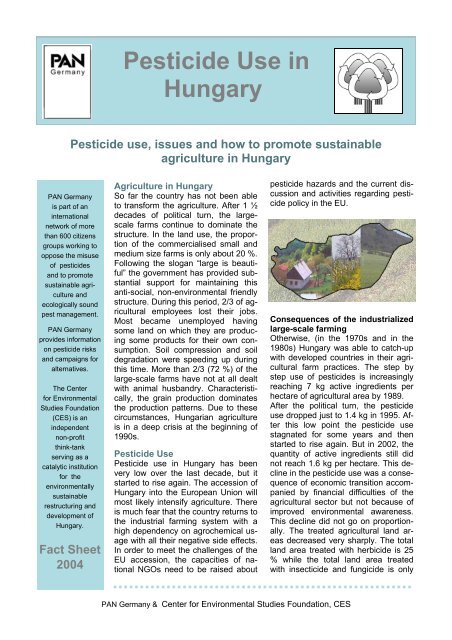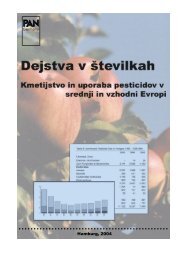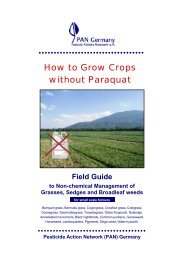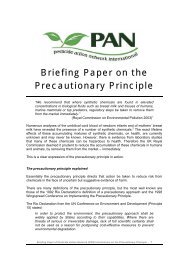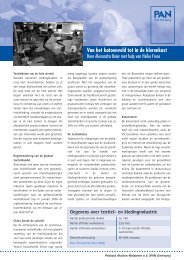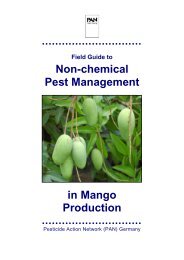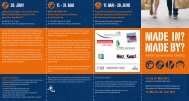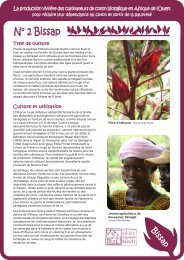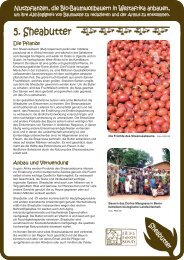Pesticide Use in Hungary - Pestizid Aktions-Netzwerk eV
Pesticide Use in Hungary - Pestizid Aktions-Netzwerk eV
Pesticide Use in Hungary - Pestizid Aktions-Netzwerk eV
Create successful ePaper yourself
Turn your PDF publications into a flip-book with our unique Google optimized e-Paper software.
<strong>Pesticide</strong> <strong>Use</strong> <strong>in</strong><br />
<strong>Hungary</strong><br />
<strong>Pesticide</strong> use, issues and how to promote susta<strong>in</strong>able<br />
agriculture <strong>in</strong> <strong>Hungary</strong><br />
PAN Germany<br />
is part of an<br />
<strong>in</strong>ternational<br />
network of more<br />
than 600 citizens<br />
groups work<strong>in</strong>g to<br />
oppose the misuse<br />
of pesticides<br />
and to promote<br />
susta<strong>in</strong>able agriculture<br />
and<br />
ecologically sound<br />
pest management.<br />
PAN Germany<br />
provides <strong>in</strong>formation<br />
on pesticide risks<br />
and campaigns for<br />
alternatives.<br />
The Center<br />
for Environmental<br />
Studies Foundation<br />
(CES) is an<br />
<strong>in</strong>dependent<br />
non-profit<br />
th<strong>in</strong>k-tank<br />
serv<strong>in</strong>g as a<br />
catalytic <strong>in</strong>stitution<br />
for the<br />
environmentally<br />
susta<strong>in</strong>able<br />
restructur<strong>in</strong>g and<br />
development of<br />
<strong>Hungary</strong>.<br />
Fact Sheet<br />
2004<br />
Agriculture <strong>in</strong> <strong>Hungary</strong><br />
So far the country has not been able<br />
to transform the agriculture. After 1 ½<br />
decades of political turn, the largescale<br />
farms cont<strong>in</strong>ue to dom<strong>in</strong>ate the<br />
structure. In the land use, the proportion<br />
of the commercialised small and<br />
medium size farms is only about 20 %.<br />
Follow<strong>in</strong>g the slogan “large is beautiful”<br />
the government has provided substantial<br />
support for ma<strong>in</strong>ta<strong>in</strong><strong>in</strong>g this<br />
anti-social, non-environmental friendly<br />
structure. Dur<strong>in</strong>g this period, 2/3 of agricultural<br />
employees lost their jobs.<br />
Most became unemployed hav<strong>in</strong>g<br />
some land on which they are produc<strong>in</strong>g<br />
some products for their own consumption.<br />
Soil compression and soil<br />
degradation were speed<strong>in</strong>g up dur<strong>in</strong>g<br />
this time. More than 2/3 (72 %) of the<br />
large-scale farms have not at all dealt<br />
with animal husbandry. Characteristically,<br />
the gra<strong>in</strong> production dom<strong>in</strong>ates<br />
the production patterns. Due to these<br />
circumstances, Hungarian agriculture<br />
is <strong>in</strong> a deep crisis at the beg<strong>in</strong>n<strong>in</strong>g of<br />
1990s.<br />
<strong>Pesticide</strong> <strong>Use</strong><br />
<strong>Pesticide</strong> use <strong>in</strong> <strong>Hungary</strong> has been<br />
very low over the last decade, but it<br />
started to rise aga<strong>in</strong>. The accession of<br />
<strong>Hungary</strong> <strong>in</strong>to the European Union will<br />
most likely <strong>in</strong>tensify agriculture. There<br />
is much fear that the country returns to<br />
the <strong>in</strong>dustrial farm<strong>in</strong>g system with a<br />
high dependency on agrochemical usage<br />
with all their negative side effects.<br />
In order to meet the challenges of the<br />
EU accession, the capacities of national<br />
NGOs need to be raised about<br />
pesticide hazards and the current discussion<br />
and activities regard<strong>in</strong>g pesticide<br />
policy <strong>in</strong> the EU.<br />
Consequences of the <strong>in</strong>dustrialized<br />
large-scale farm<strong>in</strong>g<br />
Otherwise, (<strong>in</strong> the 1970s and <strong>in</strong> the<br />
1980s) <strong>Hungary</strong> was able to catch-up<br />
with developed countries <strong>in</strong> their agricultural<br />
farm practices. The step by<br />
step use of pesticides is <strong>in</strong>creas<strong>in</strong>gly<br />
reach<strong>in</strong>g 7 kg active <strong>in</strong>gredients per<br />
hectare of agricultural area by 1989.<br />
After the political turn, the pesticide<br />
use dropped just to 1.4 kg <strong>in</strong> 1995. After<br />
this low po<strong>in</strong>t the pesticide use<br />
stagnated for some years and then<br />
started to rise aga<strong>in</strong>. But <strong>in</strong> 2002, the<br />
quantity of active <strong>in</strong>gredients still did<br />
not reach 1.6 kg per hectare. This decl<strong>in</strong>e<br />
<strong>in</strong> the pesticide use was a consequence<br />
of economic transition accompanied<br />
by f<strong>in</strong>ancial difficulties of the<br />
agricultural sector but not because of<br />
improved environmental awareness.<br />
This decl<strong>in</strong>e did not go on proportionally.<br />
The treated agricultural land areas<br />
decreased very sharply. The total<br />
land area treated with herbicide is 25<br />
% while the total land area treated<br />
with <strong>in</strong>secticide and fungicide is only<br />
••••••••••••••••••••••••••••••••••••••••••••••••••••••••<br />
PAN Germany & Center for Environmental Studies Foundation, CES
Page 2<br />
<strong>Pesticide</strong> <strong>Use</strong> <strong>in</strong> <strong>Hungary</strong><br />
Table 1:<br />
9 - 10 % of the total agricultural lands (see Table<br />
1). The farmers - ma<strong>in</strong>ly the state supported the<br />
large-scale ones - they were able to cont<strong>in</strong>ue,<br />
had enough money and used almost as much<br />
pesticides per hectare as they did 15 years ago.<br />
If we divide the total quantity of active <strong>in</strong>gredients<br />
for the treated area, the pesticide use per<br />
hectare is above 6 kg. The rest of farmers used<br />
practically no pesticides at all. From the consumers’<br />
po<strong>in</strong>t of view this situation is not favourable<br />
as they cannot tell and differentiate whether<br />
the products they buy were treated with high levels<br />
of pesticides or not.<br />
<strong>Pesticide</strong> market <strong>in</strong> <strong>Hungary</strong><br />
Until the beg<strong>in</strong>n<strong>in</strong>g of the 1990s, <strong>Hungary</strong> used<br />
to be one of the lead<strong>in</strong>g pesticide producers<br />
worldwide. It produced 60 out of the 200 most<br />
important pesticides. In 1998, the country still<br />
exported 28.800 tons of pesticides while only<br />
7762 tons <strong>in</strong> 2002. About 10 companies produce<br />
pesticides for the domestic market and the export.<br />
Nevertheless, there are also several hundreds<br />
of companies import<strong>in</strong>g pesticides, result<strong>in</strong>g<br />
<strong>in</strong> a total import of 18.654 tons <strong>in</strong> 1998 and<br />
15.000 tons <strong>in</strong> 2002.<br />
<strong>Hungary</strong> became a net importer of pesticides for<br />
the last decade. Share of home produced pesticide<br />
<strong>in</strong> money terms is less than 1/10 <strong>in</strong> the<br />
home sale. We have not researched that, but<br />
certa<strong>in</strong>ly the high price of ma<strong>in</strong>ly the imported<br />
pesticides also contributed to the low level of<br />
their use and to the high rate of illegal use.<br />
<strong>Pesticide</strong> Authorization<br />
<strong>Pesticide</strong>s application accord<strong>in</strong>g to land use categories<br />
<strong>in</strong> 2000<br />
Area treated by<br />
Land use<br />
Other<br />
categories<br />
Herbicides Insecticides Fungicides<br />
pesticides<br />
Ha % Ha % Ha % Ha %<br />
Arable land 1 459 700 32 486 078 11 559 835 12 211 701 5<br />
Orchard 9 856 10 14 240 15 14 678 15 5 389 6<br />
V<strong>in</strong>eyard 5 499 6 6 333 7 7 042 8 3 125 3<br />
Fishpond 9 0 - - - - 10 0<br />
Grassland 761 0.1 6 0 100 0 235 0<br />
Others 4 414 4 4 952 5 226 0.2 462 0.4<br />
Total 1,480,239 25 511,609 9 581,881 10 220,922 4<br />
Source:<br />
Environmental statistical data of <strong>Hungary</strong> 2000, Hungarian Central Statistical<br />
Office, Budapest 2002, p. 162<br />
Act No. 35 of 2000 on Plant Protection authorizes<br />
the M<strong>in</strong>istry of Agriculture and Regional Development<br />
for the licens<strong>in</strong>g of the market<strong>in</strong>g and<br />
use of pesticides and on the packag<strong>in</strong>g, storage<br />
and transport of pesticides.<br />
Dur<strong>in</strong>g the procedure,<br />
the M<strong>in</strong>istry obta<strong>in</strong>s<br />
the official statement<br />
of the National<br />
Public Health Centre „<br />
Fodor József” and the<br />
M<strong>in</strong>istry of Environment<br />
and Water Management.<br />
The National<br />
Public Health Centre „<br />
Fodor József” and the<br />
M<strong>in</strong>istry of Environment<br />
and Water Management<br />
are <strong>in</strong>volved <strong>in</strong> the<br />
evaluation process, but<br />
not <strong>in</strong> the authorization<br />
one. The po<strong>in</strong>ts of view of human health and environmental<br />
protection are played down. Until<br />
2004 the representatives of the NGOs have not<br />
been <strong>in</strong>volved, except the Biokultúra Egyesület<br />
(Association for Organic Culture) who is asked<br />
regard<strong>in</strong>g the chemicals that can be used <strong>in</strong> the<br />
organic farm<strong>in</strong>g. As a result of successful action<br />
of CES <strong>in</strong> 2004, an <strong>in</strong>term<strong>in</strong>isterial consultative<br />
body was set up, <strong>in</strong> which the environmental<br />
NGO movement can delegate a member.<br />
<strong>Pesticide</strong> issues<br />
Regard<strong>in</strong>g Persistent Organic Pollutants<br />
(POPs), <strong>Hungary</strong> is one of the least polluted<br />
countries <strong>in</strong> Europe. Due to very serious water<br />
pollution of Lake Balaton <strong>in</strong> the middle of 1960’<br />
the most dangerous POPs (aldr<strong>in</strong>, dieldr<strong>in</strong>, DDT,<br />
endr<strong>in</strong>, chlordane and hexachloro-benzene)<br />
were banned <strong>in</strong> 1966 (mirex and heptachlor<br />
were never permitted <strong>in</strong> <strong>Hungary</strong>).<br />
Forty years later, the Soil Conservation Information<br />
and Monitor<strong>in</strong>g System carried out an analytical<br />
test. <strong>Pesticide</strong> residue samples had been<br />
taken from the upper three genetic horizons of<br />
130 soil profiles. POPs residues were detectable<br />
<strong>in</strong> all three genetic horizons. The result of this<br />
analytical test shows that the POPs accumulate<br />
<strong>in</strong> the soil <strong>in</strong> spite of early ban.<br />
•••••••••••••••••••••••••••••••••••••••••••••••••••••••••••••••••••••<br />
PAN Germany & Center for Environmental Studies Foundation, CES
<strong>Pesticide</strong> <strong>Use</strong> <strong>in</strong> <strong>Hungary</strong> Page 3<br />
Table Toxic 2: not Chlor<strong>in</strong>ated only for pests, hydrocarbons but for humans above the<br />
<strong>Pesticide</strong>s detection can cause limits cancer, <strong>in</strong> <strong>Hungary</strong> reproductive and<br />
Source: Növény és Talajvédelmi Központi Szolgálat<br />
developmental (Central toxicity, Service for endocr<strong>in</strong>e Plant and Soil disruption Protection) and<br />
chol<strong>in</strong>esterase Budapest, <strong>in</strong>hibition 1996-97 to human bodies. Various<br />
<strong>in</strong>ternational established criteria for the<br />
evaluation of the human toxicity exist.<br />
A survey conducted showed that 180 of the <strong>in</strong>gredients<br />
registered <strong>in</strong> <strong>Hungary</strong> are classified by<br />
the European Union re: 25 as very toxic, 34 as<br />
toxic, 87 as harmful and 19 as irritant 1 .<br />
<strong>Pesticide</strong> residues <strong>in</strong> dr<strong>in</strong>k<strong>in</strong>g water<br />
<strong>Pesticide</strong> residues <strong>in</strong> surface and ground waters<br />
have been monitored regularly <strong>in</strong> <strong>Hungary</strong> s<strong>in</strong>ce<br />
1976 - <strong>in</strong> the framework of the National Environmental<br />
Health Program. In 2000, 64 sampl<strong>in</strong>g<br />
po<strong>in</strong>ts along rivers, small creeks, and canals<br />
were selected from each ma<strong>in</strong> agricultural area.<br />
From the 62 sample po<strong>in</strong>ts, 21 pesticides were<br />
analysed. 8 pesticides were found and 8 cases<br />
exceeded the EU limits.<br />
Table 3: <strong>Pesticide</strong> residues <strong>in</strong> dr<strong>in</strong>k<strong>in</strong>g water<br />
<strong>in</strong> <strong>Hungary</strong> <strong>in</strong> 2000<br />
Name of active<br />
<strong>in</strong>gredient<br />
Number of<br />
occurrence<br />
Above the<br />
EU limit<br />
Maximal<br />
concentration<br />
µg/l<br />
Diazion 14 2 0.33<br />
Forat 4 0 0.01<br />
Antraz<strong>in</strong> 5 3 5.70<br />
Prometr<strong>in</strong> 1 1 3.22<br />
Terbutr<strong>in</strong> 1 0 0.05<br />
2.4-D 4 1 0.27<br />
Dichlorprop 3 0 0.07<br />
MCPA 5 1 0.68<br />
Number of water basis: 62, number of <strong>in</strong>vestigated active<br />
<strong>in</strong>gredients: 21<br />
Source: Data provided by the Hungarian “Central<br />
Service for Plant and Soil Protection”<br />
1 Lars Neumeister (2003): <strong>Pesticide</strong>s <strong>in</strong> CEEC’s - Usage,<br />
Registration, Identification and Evaluation, Part 2: <strong>Hungary</strong>.<br />
PAN Germany, Hamburg<br />
<strong>Pesticide</strong> residues <strong>in</strong> the home<br />
produced food <strong>in</strong> <strong>Hungary</strong> <strong>in</strong> 2002 (%)<br />
<strong>Pesticide</strong> residues <strong>in</strong> the imported<br />
food <strong>in</strong> <strong>Hungary</strong>, <strong>in</strong> 2002 (%)<br />
Figure 1: <strong>Pesticide</strong> residues <strong>in</strong> domestic<br />
and imported food, Hungaria 2002<br />
Source: http://www.ontsz.hu/kep/letolt_172.pdf<br />
<strong>Pesticide</strong> residues <strong>in</strong> food<br />
In 60% of the analysed home produced food,<br />
there were no measurable residues. Only <strong>in</strong><br />
1% were the residues above the Maximum Residue<br />
Limit (MRL) (Figure 1). In 12% of all cases<br />
non-authorized were detected (above and below<br />
MRL). A list of the use of non-permitted pesticides<br />
is very long. Most of the pesticides are authorized<br />
<strong>in</strong> <strong>Hungary</strong>, but not for agricultural<br />
crops. Also such pesticides were found, that<br />
were banned <strong>in</strong> <strong>Hungary</strong>. An example of a heavily<br />
sprayed vegetable is lettuce. Altogether,<br />
some 40% of the domestic samples conta<strong>in</strong>ed<br />
pesticide residues.<br />
<strong>Pesticide</strong> residues <strong>in</strong> the imported foods were<br />
higher than <strong>in</strong> the home produced foods (56%).<br />
As the imported foods are bought to a much<br />
higher degree <strong>in</strong> Budapest than <strong>in</strong> other parts of<br />
<strong>Hungary</strong>, the contam<strong>in</strong>ation of the persons liv<strong>in</strong>g<br />
<strong>in</strong> Budapest is higher than <strong>in</strong> the rural areas of<br />
the country.<br />
Towards Susta<strong>in</strong>able Agriculture<br />
The Integrated Crop Management Scheme<br />
(ICMS) was <strong>in</strong>troduced <strong>in</strong> <strong>Hungary</strong> <strong>in</strong> 2002,<br />
based on Government Resolution 2253/1999<br />
Government decree on the <strong>in</strong>troduction of the<br />
National agri-environment Programme. There is<br />
a substantially <strong>in</strong>creased demand for safe and<br />
quality foodstuffs <strong>in</strong> <strong>Hungary</strong> - and <strong>in</strong> Europe as<br />
well. The ICMS is designed to encourage farmers<br />
to use <strong>in</strong>tegrated farm<strong>in</strong>g methods to produce<br />
accord<strong>in</strong>g to higher environmental standards.<br />
In 2003, about 13.000 hectares (0.2 %) of<br />
agricultural area was used by ICMS.<br />
•••••••••••••••••••••••••••••••••••••••••••••••••••••••••••••••••••••<br />
PAN Germany & Center for Environmental Studies Foundation, CES)<br />
No measurable<br />
residues (60)<br />
Residues below MRL<br />
(27)<br />
Residues above MRL<br />
(1)<br />
Residues of non-permitted<br />
pesticides (12)<br />
No measurable<br />
residues (44)<br />
Residues below MRL<br />
(55)<br />
Residues above MRL<br />
(1)<br />
Residues of non-permitteted<br />
pesticides (0)
Page 4<br />
<strong>Pesticide</strong> <strong>Use</strong> <strong>in</strong> <strong>Hungary</strong><br />
The importance of organic farm<strong>in</strong>g has been <strong>in</strong>creas<strong>in</strong>gly<br />
appreciated <strong>in</strong> <strong>Hungary</strong> <strong>in</strong> recent<br />
years. In addition to the <strong>in</strong>creas<strong>in</strong>g importance<br />
of environmentally sensitive farm<strong>in</strong>g pr<strong>in</strong>ciples,<br />
<strong>in</strong>creas<strong>in</strong>g demand for organic products and<br />
new market opportunities justify the significance<br />
of organic farm<strong>in</strong>g. Only 10 % or less of organic<br />
products are purchased by the home consumers.<br />
Table 4: Number of organic hold<strong>in</strong>gs and<br />
areas<br />
Year<br />
Number of Size of organic<br />
hold<strong>in</strong>g s areas (ha)<br />
1995 108 8 232<br />
1996 127 11 397<br />
1997 161 15 772<br />
1998 330 21 565<br />
1999 327 32 609<br />
2000 471 47 221<br />
2001 764 79 178<br />
2002 995 103 672<br />
Source: http://www.biokontroll.hu/eves/<strong>in</strong>dex.html<br />
Ma<strong>in</strong> targets for NGOs’ action<br />
• Raise the pesticides related awareness and<br />
ensure greater transparency and consultation<br />
with public <strong>in</strong>terest groups.<br />
• Ensure NGO’s participation <strong>in</strong> the evaluation<br />
and authorisation process.<br />
• Promote the susta<strong>in</strong>able pesticide use with<br />
elim<strong>in</strong>ation of the obsolete pesticides and<br />
with reduction of the pesticide utilisation.<br />
• Take action to address data gaps, comb<strong>in</strong>ation<br />
effects, newly recognised effects like<br />
endocr<strong>in</strong>e disrupt<strong>in</strong>g potential and immunotoxicity.<br />
• Promot<strong>in</strong>g apply of the Good Farm<strong>in</strong>g Practice<br />
(GFP) and Good Plant Protection Practice<br />
(<strong>in</strong>clud<strong>in</strong>g IPM).<br />
• Promot<strong>in</strong>g specific policies and support to<br />
br<strong>in</strong>g 5% of all cultivated land under organic<br />
production (as def<strong>in</strong>ed by IFOAM) by the<br />
year 2005/2006.<br />
National contacts and l<strong>in</strong>ks<br />
Responsible m<strong>in</strong>istries and authorization bodies:<br />
M<strong>in</strong>istry of Agriculture & Rural Development, Budapest<br />
PO Box 1, Kossuth tér 11, H-1860, <strong>Hungary</strong><br />
M<strong>in</strong>istry of Environment and Water Management, Budapest,<br />
Fö utca 44-50, H-1011, <strong>Hungary</strong>, <strong>Hungary</strong><br />
”Fodor József” National Public Health Centre, Budapest,<br />
Nayvárad tér 2, H-1097, <strong>Hungary</strong><br />
Central Service for Plant and Soil Protection, Budapest,<br />
Budaörsi út 41-45, H-1118, <strong>Hungary</strong><br />
Hungarian Food Safety Office, Budapest, Miklós tér 1,<br />
H-1035, <strong>Hungary</strong><br />
NGOs work<strong>in</strong>g on susta<strong>in</strong>able agriculture issues<br />
Center for Environmental Studies Foundation (CES)<br />
Budapest, Angyal utca 15, B/4, H-1094, <strong>Hungary</strong><br />
phone: +36 1 216 0377, fax: +36 1 216 0911<br />
E-mail: laczo@ktk-ces.hu, www.ktk-ces.hu<br />
WWF <strong>Hungary</strong><br />
Budapest, Nemetvolgyi út 78/B, H-1124, <strong>Hungary</strong><br />
phone: +36 1 214 5554, fax: +36 1 212 9353<br />
E-mail: ferenc.kis@wwf.hu, www.wwf.hu<br />
Greenpeace<br />
Budapest, Tárogató út 40, H-1021, <strong>Hungary</strong><br />
Tel: +36 1 392 7663, Fax: +36 1 200 8484<br />
Email: <strong>in</strong>fo@greenpeace.hu, Internet: www.greenpeace.hu<br />
Association for Organic Culture,<br />
Budapest, Fő út 28, H-1011, phone/fax: +36 1 2147005,<br />
E-mail: <strong>in</strong>fo@ biokultura.org, www.biokultura.org<br />
Green Women, Budapest, Tomori u.23.II.14, H-1138, <strong>Hungary</strong>,<br />
phone: +36 1 320 6869, fax: +36 1 340 6097<br />
E-mail: jhalasz@levego.hu<br />
Clean Air Action Group<br />
Budapest, Károly körút 3/a, H-1075, <strong>Hungary</strong><br />
phone: +36 1 411 05-09/-10, fax: +36 1 266 0150<br />
E-mail: levego@levego.hu, www.levego.hu<br />
National Society of Conservationists/Friends of the Earth,<br />
<strong>Hungary</strong>, Budapest, Üllői út 91/b, H-1091, <strong>Hungary</strong><br />
Phone: +36 1 216 7297 Fax: +36 1 216 7295<br />
E-mail: fidusz@zpok.hu<br />
Published by <strong>Pesticide</strong> Action Network Germany (PAN<br />
Germany) <strong>in</strong> co-operation with Center for Environmental<br />
Studies Foundation, CES<br />
2004<br />
Pr<strong>in</strong>cipal Author: Ferenc Laczó (CES)<br />
Editor: Susanne Smolka (PAN Germany)<br />
<strong>Pestizid</strong> <strong>Aktions</strong>-<strong>Netzwerk</strong> e.V. (PAN Germany)<br />
Nernstweg 32, 22765 Hamburg, Germany,<br />
phone: +49 (0) 40-399 19 10-0, fax: +49 (0) 40-390 75 20<br />
E-mail: <strong>in</strong>fo@pan-germany.org, www.pan-germany.org<br />
Center for Environmental Studies Foundation, CES<br />
Angyal utca 15, B/4, 1094 Budapest, <strong>Hungary</strong><br />
phone/fax: +36 1 216 0377, fax: +36 1 216 0911<br />
E-mail: laczo@ktk-ces.hu, www.ktk-ces.hu<br />
Permission is granted to reproduce any and all portions of<br />
this fact sheet, provided the publisher, title and author are<br />
acknowledged.<br />
Funds for this project were made available by the<br />
Raus<strong>in</strong>g Trust (United K<strong>in</strong>gdom). This support is gratefully<br />
acknowledged.<br />
•••••••••••••••••••••••••••••••••••••••••••••••••••••••••••••••••••••<br />
PAN Germany & Center for Environmental Studies Foundation, CES


